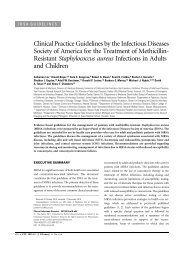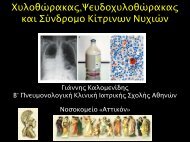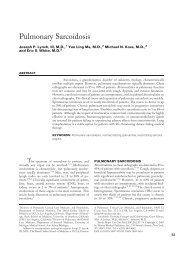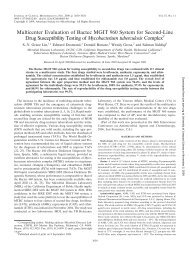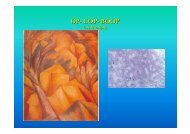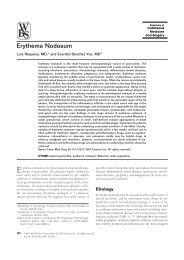ADVANCES IN IMMUNOLOGY Membrane-bound IgE Histamine, leukotrienes, platelet-activating factor Mast cell Interleukin-4 Interleukin-5 Acute <strong>Allergic</strong> Reaction Wheezing Urticaria Sneezing, rhinorrhea, conjunctivitis B cell Allergen IgE production Eosinophil Basic proteins, leukotrienes, platelet-activating factor Interleukin-4 Dendritic cell Th2 Interleukin-5 Chronic <strong>Allergic</strong> Reaction MHC class II molecule T-cell receptor Histamine-releasing factor, neuropeptides Neurotrophins Mast cell Histamine, lipids, cytokines Further wheezing Sustained blockage of the nose Eczema Neuropeptides Figure 3. Pathways Leading to Acute <strong>and</strong> Chronic <strong>Allergic</strong> Reactions. Acute allergic reactions are due to the antigen-induced release of histamine <strong>and</strong> lipid mediators from mast cells. In the skin <strong>and</strong> upper airways, basophils (not shown) may also participate in allergic tissue reactions. Chronic allergic reactions, including the latephase reaction, may depend on a combination of pathways, including the recruitment of eosinophils, the liberation of mast-cell products by histamine-releasing factors, 62 <strong>and</strong> neurogenic inflammation involving neurotrophins <strong>and</strong> neuropeptides. MHC denotes major histocompatibility complex. promote the overproduction of mucus (Table 1). Eosinophils can injure mucosal surfaces by releasing toxic basic proteins, cysteinyl leukotrienes, <strong>and</strong> plateletactivating factor. They also damage inhibitory M2 muscarinic receptors, which may allow unchecked cholinergic responses in patients with asthma. 51 By contrast, eosinophils may also repair damage, since they produce fibrogenic growth factors <strong>and</strong> matrix metalloproteinase, which remodel airway tissue in asthma. 52 Interleukin-5 releases both mature <strong>and</strong> immature eosinophils from the bone marrow, 53 regulates the expression of the transmembrane isoform of its own receptor, 54 <strong>and</strong> is essential for the terminal differentiation of committed eosinophil precursors. 55 The preferential accumulation of eosinophils occurs through the interactions between selective adhesion molecules (a 4 b 1 integrin <strong>and</strong> vascular-cell adhesion molecule), the migration of eosinophils toward receptors for CC chemokines as a result of recruitment by eotaxin-1, eotaxin-2, eotaxin-3, RANTES, monocyte chemotactic protein (MCP) 3 <strong>and</strong> MCP-4; prolonged survival (delayed apoptosis) under the influence of interleukin-5, interleukin-3, <strong>and</strong> granulocyte–macrophage colonystimulating factor; <strong>and</strong> the local differentiation of tis- N Engl J Med, Vol. 344, No. 1 · January 4, 2001 · www.nejm.org · 35 Downloaded from www.nejm.org by VASSILAKOPOULOS THEODOROS MD on April 1, 2009 . Copyright © 2001 Massachusetts Medical Society. All rights reserved.
The New Engl<strong>and</strong> Journal of Medicine sue-infiltrating eosinophil precursors induced by interleukin-5. 56 <strong>Allergic</strong> inflammation may also follow the release of neuropeptides from nerve cells by the action of nerve growth factor, brain-derived neurotrophic factor, <strong>and</strong> neurotrophin-3. 57,58 These neurotrophins are secreted by macrophages, T cells, eosinophils, <strong>and</strong> mast cells. 58 Neuropeptides, particularly substance P, calcitonin-gene–related peptide, <strong>and</strong> neurokinin A (all of which are located predominantly in sensory neurons, but also in inflammatory cells), cause characteristic features of allergic inflammation, including vasodilatation, increased vascular permeability, <strong>and</strong> in the lung, contraction of the smooth muscles of the airway <strong>and</strong> hypersecretion of mucus. 59 They also release histamine from mast cells in the lungs. 60 Tryptase can also trigger nerve cells to release neuropeptides by binding to protease-activated receptors. Further amplifications of chronic allergic reactions may be mediated by histamine-releasing factor or factors. 61 Pathways leading to acute <strong>and</strong> chronic allergic reactions are shown in Figure 3. REFERENCES 1. Aberg N, Hesselmar B, Aberg B, Eriksson B. Increase of asthma, allergic rhinitis <strong>and</strong> eczema in Swedish schoolchildren between 1979 <strong>and</strong> 1991. Clin Exp <strong>Allergy</strong> 1995;25:815-9. 2. Smith DH, Malone DC, Lawson KA, Okamoto LJ, Battista C, Saunders WB. A national estimate of the economic costs of asthma. Am J Respir Crit Care Med 1997;156:787-93. 3. von Pirquet C. <strong>Allergy</strong>. In: Gell PGH, Coombs RRA, eds. Clinical aspects of immunology. Oxford, Engl<strong>and</strong>: Blackwell Scientific, 1963. 4. Kemeny DM, Urbanek R, Ewan P, et al. The subclass of IgG antibody in allergic disease. II. The IgG subclass of antibodies produced following natural exposure to dust mite <strong>and</strong> grass pollen in atopic <strong>and</strong> non-atopic individuals. Clin Exp <strong>Allergy</strong> 1989;19:545-9. 5. Romagnani S. Human TH1 <strong>and</strong> TH2 subsets: doubt no more. Immunol Today 1991;12:256-7. 6. Ebner C, Schenk S, Najafian N, et al. Nonallergic individuals recognize the same T cell epitopes of Bet v 1, the major birch pollen allergen, as atopic patients. J Immunol 1995;154:1932-40. 7. Till S, Durham S, Dickason R, et al. IL-13 production by allergen-stimulated T cells is increased in allergic disease <strong>and</strong> associated with IL-5 but not IFN-gamma expression. Immunology 1997;91:53-7. 8. Kay AB, Ying S, Varney V, et al. Messenger RNA expression of the cytokine gene cluster interleukin 3 (IL-3), IL-4, IL-5 <strong>and</strong> granulocyte/macrophage colony-stimulating factor, in allergen-induced late-phase cutaneous reactions in atopic subjects. J Exp Med 1991;173:775-8. 9. Robinson DS, Hamid Q, Ying S, et al. Predominant T H2 -type bronchoalveolar T-lymphocyte population in atopic asthma. N Engl J Med 1992; 326:298-304. 10. Durham SR, Ying S, Varney VA, et al. Cytokine messenger RNA expression for IL-3, IL-4, IL-5 <strong>and</strong> granulocyte/macrophage-colony-stimulating factor in the nasal mucosa after local allergen provocation: relationship to tissue eosinophilia. J Immunol 1992;148:2390-4. 11. Prescott S, Macaubas C, Holt BJ, et al. Transplacental priming of the human immune system to environmental allergens: universal skewing of initial T cell responses toward the Th2 cytokine profile. J Immunol 1998; 160:4730-7. 12. Holt PG, Macaubas C, Stumbles PA, Sly PD. The role of allergy in the development of asthma. Nature 1999;402:Suppl:B12-B17. 13. Constant SL, Bottomly K. Induction of Th1 <strong>and</strong> Th2 CD4+ T cell responses: the alternative approaches. Annu Rev Immunol 1997;15:297-322. 14. Rogers PR, Croft M. Peptide dose, affinity, <strong>and</strong> time of differentiation can contribute to the Th1/Th2 cytokine balance. J Immunol 1999;163: 1205-13. 15. Caramori G, Lim S, Ciaccia A, Fabbri LM, Barnes PJ, Adcock IM. GATA transcription factors expression in T cells, monocytes <strong>and</strong> bronchial biopsies of normal <strong>and</strong> asthmatic subjects. Am J Respir Crit Care Med 1999;157:Suppl:A908. abstract. 16. von Mutius E, Martinez FD, Fritzsch C, Nicolai T, Roell G, Thiemann HH. Prevalence of asthma <strong>and</strong> atopy in two areas of East <strong>and</strong> West Germany. Am J Respir Crit Care Med 1994;149:358-64. 17. von Mutius E, Weil<strong>and</strong> SK, Fritzsch C, Duhme H, Keil U. Increasing prevalence of hay fever <strong>and</strong> atopy among children in Leipzig, East Germany. Lancet 1998;351:862-6. 18. Rook GA, Stanford JL. Give us this day our daily germs. Immunol Today 1998;19:113-6. 19. Sepp E, Julge K, Vasar M, Naaber P, Bjorksten B, Mikelsaar M. Intestinal microflora of Estonian <strong>and</strong> Swedish infants. Acta Paediatr 1997;86: 956-61. 20. Bjorksten B, Naaber P, Sepp E, Mikelsaar M. The intestinal microflora in allergic Estonian <strong>and</strong> Swedish 2-year-old children. Clin Exp <strong>Allergy</strong> 1999;29:342-6. [Erratum, Clin Exp <strong>Allergy</strong> 2000;30:1047.] 21. Braun-Fahrländer C, Gassner M, Grize L, et al. Prevalence of hay fever <strong>and</strong> allergic sensitization in farmer’s children <strong>and</strong> their peers living in the same rural community. Clin Exp <strong>Allergy</strong> 1999;29:28-34. 22. Cookson W. The alliance of genes <strong>and</strong> environment in asthma <strong>and</strong> allergy. Nature 1999;402:Suppl:B5-B11. 23. Openshaw PJM, Hewitt C. Protective <strong>and</strong> harmful effects of viral infections in childhood on wheezing disorders <strong>and</strong> asthma. Am J Respir Crit Care Med 2000;162:Suppl:S40-S43. 24. Ball TM, Castro-Rodriguez JA, Griffith KA, Holberg CJ, Martinez FD, Wright AL. Siblings, day-care attendance, <strong>and</strong> the risk of asthma <strong>and</strong> wheezing during childhood. N Engl J Med 2000;343:538-43. 25. Schwartz J, Gold D, Dockery DW, Weiss ST, Speizer FE. Predictors of asthma <strong>and</strong> persistent wheeze in a national sample of children in the United States: association with social class, perinatal events, <strong>and</strong> race. Am Rev Respir Dis 1990;142:555-62. 26. Call RS, Smith TF, Morris E, Chapman MD, Platts-Mills TA. Risk factors for asthma in inner city children. J Pediatr 1992;121:862-6. 27. Holgate ST. The epidemic of allergy <strong>and</strong> asthma. Nature 1999;402: Suppl:B2-B4. 28. Burks W, Sampson HA, Bannon GA. Peanut allergens. <strong>Allergy</strong> 1998; 53:725-30. 29. Marsh DG, Hsu SH, Roebber M, et al. HLA-Dw2: a genetic marker for human immune response to short ragweed pollen allergen Ra 5. I. Response resulting primarily from natural antigenic exposure. J Exp Med 1982;155:1439-51. 30. Hill MR, Cookson WOCM. A new variant of the b subunit of the high-affinity receptor for immunoglobulin E (FceRI-b E237G): associations with measures of atopy <strong>and</strong> bronchial hyper-responsiveness. Hum Mol Genet 1996;5:959-62. 31. Marsh DG, Neely JD, Breazeale DR, et al. Linkage analysis of IL4 <strong>and</strong> other chromosome 5q31.1 markers <strong>and</strong> total serum immunoglobulin E concentrations. Science 1994;264:1152-6. 32. Moffatt MF, Cookson WOCM. Tumour necrosis factor haplotypes <strong>and</strong> asthma. Hum Mol Genet 1997;6:551-4. 33. Baldini M, Lohman IC, Halonen M, Erickson RP, Holt PG, Martinez FD. A polymorphism in the 5'-flanking region of the CD14 gene is associated with circulating soluble CD14 levels <strong>and</strong> with total serum immunoglobulin E. Am J Respir Cell Mol Biol 1999;20:976-83. 34. Drazen JM, Y<strong>and</strong>ava CN, Dube L, et al. Pharmacogenetic association between ALOX5 promoter genotype <strong>and</strong> the response to anti-asthma treatment. Nat Genet 1999;22:168-70. 35. Kinet JP. The high-affinity IgE receptor (Fc epsilon RI): from physiology to pathology. Annu Rev Immunol 1999;17:931-72. 36. Stingl G, Maurer D. IgE-mediated allergen presentation via FceRI on antigen-presenting cells. Int Arch <strong>Allergy</strong> Immunol 1997;113:24-9. 37. Smith SJ, Ying S, Meng Q, et al. Blood eosinophils from atopic donors express messenger RNA for the a, b <strong>and</strong> g subunits of the high-affinity IgE receptor (FceRI) <strong>and</strong> intracellular, but not cell surface, a subunit protein. J <strong>Allergy</strong> Clin Immunol 2000;105:309-17. 38. Corry DB, Kheradm<strong>and</strong> F. Induction <strong>and</strong> regulation of the IgE response. Nature 1999;402:Suppl:B18-B23. 39. Robinson D, Shibuya K, Mui A, et al. IGIF does not drive Th1 development but synergizes with IL-12 for interferon-g production <strong>and</strong> activates IRAK <strong>and</strong> NFkB. Immunity 1997;7:571-81. 40. Yoshimoto T, Nagai N, Ohkusu K, Ueda H, Okamura H, Nakanishi K. LPS-stimulated SJL macrophages produce IL-12 <strong>and</strong> IL-18 that inhibit IgE production in vitro by induction of IFN-gamma production from CD3intIL-2Rb+ T cells. J Immunol 1998;161:1483-92. 41. Squire CM, Studer EJ, Lees A, Finkelman FD, Conrad DH. Antigen presentation is enhanced by targeting antigen to the FceRII by antigenanti-FceRII conjugates. J Immunol 1994;152:4388-96. 42. Gustavsson S, Hjulstrom S, Liu T, Heyman B. CD23/IgE-mediated regulation of the specific antibody response in vivo. J Immunol 1994;152: 4793-800. 43. Drazen JM, Israel E, O’Byrne PM. Treatment of asthma with drugs modifying the leukotriene pathway. N Engl J Med 1999;340:197-206. [Errata, N Engl J Med 1999;340:663, 341:1632.] 36 · N Engl J Med, Vol. 344, No. 1 · January 4, 2001 · www.nejm.org Downloaded from www.nejm.org by VASSILAKOPOULOS THEODOROS MD on April 1, 2009 . Copyright © 2001 Massachusetts Medical Society. All rights reserved.



